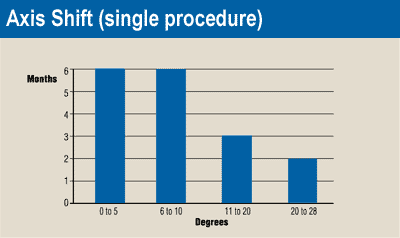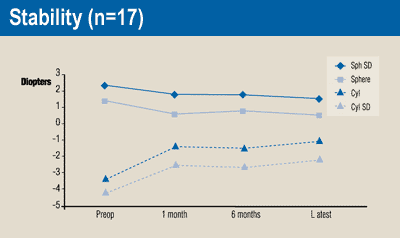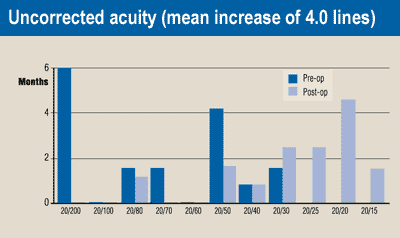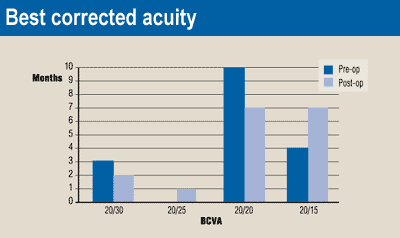Study: negative cylinder ablations favorable to other methods
Positive and crossed methods ablate less tissue, but negative ablations give better visual results.
 MONTREAL — Negative cylinder
ablations provide better visual outcomes than positive or crossed cylinder
methods, according to Gordon A. Balazsi, MD, of Clinique Laservue here.
MONTREAL — Negative cylinder
ablations provide better visual outcomes than positive or crossed cylinder
methods, according to Gordon A. Balazsi, MD, of Clinique Laservue here.
Mixed astigmatism occurs in about 1% of patients presenting to a refractive practice, Dr. Balazsi said. It usually presents bilaterally with very little amblyopia. While the patients are highly motivated to get rid of their rigid and soft toric lenses, their only option until recently has been astigmatic keratotomy.
Mixed astigmatism could not be corrected very effectively until the advent of scanning lasers, Dr. Balazsi said. It can be corrected by either steepening the flat axis (“positive cylinder method”), flattening the steep axis (“negative cylinder method”) or a combination of both (“crossed cylinder method”).
He conducted a study to evaluate the efficacy, safety and optical results of a pilot group of mixed astigmatism patients treated only by the negative cylinder method of flattening the steep axis. He compared it to results from positive cylinder methods that he presented 2 years ago.
Positive cylinder method
 At the 1998 ASCRS meeting, he presented his
data from the use of the positive cylinder method. The treatment was safe, he
said. Three of 17 patients gained one line of acuity, and no patients lost
best-corrected visual acuity (BCVA).
At the 1998 ASCRS meeting, he presented his
data from the use of the positive cylinder method. The treatment was safe, he
said. Three of 17 patients gained one line of acuity, and no patients lost
best-corrected visual acuity (BCVA).
The patients were “remarkably” tolerant of residual spherical refractive error, and their uncorrected visual acuity data indicated some degree of multifocal vision.
“Intuitively, the positive cylinder method should be better, because it removes less tissue depth than the negative one,” Dr. Balazsi said. “The refractive data were very good, but I was disappointed in my patients’ assessment of their quality of vision. The patients had narrow topographical optical zones. This led me to investigate the negative cylinder method.”
Negative cylinder method
 To assess the negative cylinder method, Dr.
Balazsi enrolled 17 eyes of 11 patients with mixed astigmatism. Their mean age
was 34.9 years, with a range of 24 to 42.
To assess the negative cylinder method, Dr.
Balazsi enrolled 17 eyes of 11 patients with mixed astigmatism. Their mean age
was 34.9 years, with a range of 24 to 42.
The study population had a mean sphere of +1.47 D, with a range of +0.50 D to 3 D. The mean cylinder was –3.25 D, with a range of –1.25 D to –5 D. The median uncorrected visual acuity (UCVA) was 20/70, with a range of 20/30 to 20/200. The median BCVA was 20/20, with a range of 20/15 to 20/30.
LASIK was performed using the ACS keratome and the Tecnolas 217 (Bausch & Lomb, Claremont, U.S.A.) scanning laser to ablate hyperopic sphere with one-third cylinder added to correct for the coupling effect. He also ablated the full minus cylinder correction.
The mean treated sphere was +1.97 D, with a range of +0.75 D to +3.75 D. The optical zone was 5.7 mm. The mean treated cylinder was –3.19 D, with a range of –1.25 D to –5 D, with an optical zone between 5.5 mm and 6 mm.
Central ablation depth of the cylindrical component was a mean of 47.1 µm, with a range of 17 µm to 76 µm. Peripheral ablation of the hyperopic component was a mean of 32.6 µm, with a range of 12 µm to 63 µm. Maximum ablation depth at 2.6-2.8 mm eccentric was a mean of 79.7 µm, with a range of 29 µm to 133 µm.
 The minimum follow-up was 26 weeks, and the mean was 33.6
weeks. The furthest any patient was followed was 56 weeks. At 6 months, the
mean UCVA improved by 4 lines.
The minimum follow-up was 26 weeks, and the mean was 33.6
weeks. The furthest any patient was followed was 56 weeks. At 6 months, the
mean UCVA improved by 4 lines.
At 6 months, no eye lost BCVA. Four of 17 gained one line, and the median BCVA was 20/15. Also, eight eyes were within 0.5 D of intended spherical equivalent correction, 16 were within 1 D and all eyes were within 1.25 D. At last follow-up, 10 were within 0.5 D, and all were within 1 D.
At 6 months, five eyes were within 0.5 D of predicted cylindrical correction, nine were within 1 D and 16 were within 2 D. One eye remained at 4 D. At last follow-up, two more eyes improved to within 0.5 D, and the rest remained stable.
He reviewed refractive data and compared typical topographies of negative cylinder patients compared to the previous series of positive cylinder patients.
“In general, the optical zones are more regular and are wider,” he said. “The issue of depth of ablation was specifically addressed at the central cornea as well as calculated at the 2.6 to 2.8 mm eccentric zone, where there is maximal ablation of the hyperopia component and the negative cylindrical component. No case even approached the theoretical limit of leaving at least 250 µm of intact stroma.”
Half-measures
 The negative cylinder correction method
yields excellent refractive data for UCVA, BCVA, predictability, stability and
cylinder, Dr. Balazsi said.
The negative cylinder correction method
yields excellent refractive data for UCVA, BCVA, predictability, stability and
cylinder, Dr. Balazsi said.
The topographies of patients treated with negative cylinder ablations show a better pattern compared to positive cylinder correction.
Crossed cylinder ablation has also been discussed recently, Dr. Balazsi said. This pattern uses sequential simple myopic and simple hyperopic cylindrical corrections on both axis.
“Recently, it has been in vogue to advocate a mixture where part of the astigmatism of the eye is treated in the positive mode, and part in the negative mode, presumably to at least improve on the narrow optical zones I had previously demonstrated with the positive mode, at the expense of some deeper treatment,” Dr. Balazsi told Ocular Surgery News.
According to his research, Dr. Balazsi said that using the negative cylinder mode yields better topography in the central optical zone than the positive mode, without ablating too deeply for currently accepted standards.
“If this is the case, why bother with the crossed technique, which currently requires two programmings of the laser computer, with an interval in between where the cornea can dry out leading to further variability of results,” he said. “The negative cylinder method only requires a double programming in extreme cases of high mixed astigmatism.”
For Your Information:
- Gordon A. Balazsi, MD, can be reached at Clinique Laservue, 1100 Beaumont Ave., #201, Mount Royal QB H3P 3H5, Montreal, Canada; +(1) 514-738-6666; fax: +(1) 514-738-1769; e-mail: laservue@laservue.net. Dr. Balazsi has no direct financial interest in any of the products mentioned in this article, nor is he a paid consultant for any companies mentioned.
